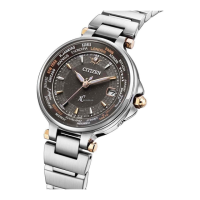2
WThis watch is a radio wave watch that W
receives the standard time radio wave
transmitted in Germany.
This radio wave watch is equipped with a regular automatic reception
function that sets the time and date by automatically receiving radio
waves twice a day at 3:00 AM and 4:00 AM, and a free reception
function that allows the time to be set arbitrarily by receiving radio
waves. A time difference can also be set in 1 hour units based on
German standard time.
3
English
The design may differ according to the model.
Hour hand
Button (B)
Minute hand
H,M,L:
Reception level/
Reception result
Second hand
No: Reception result
SET:
Indicated when a
time difference has
been set
±0:
Indicated when
no time
difference has
been set
Button (A)
Crown
Shorter end of
second hand
RX:Reception standby
(start of radio wave reception)
Crown for turning
the outer scale
L
This watch indicates the reception level and reception result with the shorter end of the second hand.







